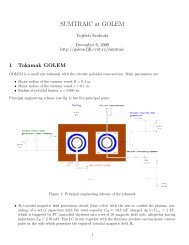IRD Catalogue 2007 - Golem
IRD Catalogue 2007 - Golem
IRD Catalogue 2007 - Golem
You also want an ePaper? Increase the reach of your titles
YUMPU automatically turns print PDFs into web optimized ePapers that Google loves.
CW Responsivity:<br />
Center figure on the front inside cover shows typical CW<br />
responsivity of the AXUV/SXUV/UVG photodiodes. As the<br />
responsivity is quantum efficiency divided by the<br />
corresponding photon energy, the AXUV photodiode<br />
responsivity can also be calculated from Fig. 3. Note that the<br />
AXUV responsivity has the theoretical value of 0.275 A/W for<br />
short wavelength photons.<br />
As seen in the figure, responsivity of the SXUV photodiodes is<br />
significantly lower than the responsivity of the AXUV series<br />
diodes due to the surface recombination present in these<br />
devices.<br />
Owing to their extremely thin (4 to 8 nm) entrance window,<br />
AXUV diodes exhibit near theoretical response to low energy<br />
electrons and hydrogen ions. The bottom figure on the front<br />
inside cover shows the responsivity of AXUV photodiodes to<br />
photons with 10 eV to 4000 eV energy and to electrons and<br />
hydrogen ions with 100 eV to 40,000 eV energy [3-5]. Figure<br />
4 shows the same information in terms of gain for 80 eV to<br />
40,000 eV electrons.<br />
Q = (1/R) ∫ Vdt<br />
This integral was evaluated using the oscilloscope’s built-in<br />
area function. The pulse energy of the PSX100 was measured<br />
with an Ophir Laserstar with PE10 pyroelectric detector head<br />
which has an uncertainty of approximately 10% with 2 µJ<br />
incident pulse energy at 193 nm.<br />
The pulse responsivity (charge generated per unit energy<br />
incident) was calculated by dividing the measured charge<br />
created in the detector by the measured pulse energy. As seen<br />
in Table 1, the correlation between the cw and pulsed 193 nm<br />
response agrees with previous results for visible wavelengths<br />
[6]. This experimental verification that the cw responsivity can<br />
be used to measure pulse energy is critical to radiometric<br />
measurements of 13 nm pulses for which no primary standards<br />
are presently available.<br />
As the UV/EUV, light pulses are very destructive to sensors<br />
because of the high flux levels involved, SXUV photodiodes<br />
were developed specifically for sources with high flux levels to<br />
yield years of operation without noticeable degradation.<br />
Gain<br />
10000<br />
1000<br />
100<br />
Unlike pyroelectric detectors which have only five to six<br />
orders of magnitude dynamic range and a significant nonuniformity<br />
of response across the surface, SXUV series<br />
photodiodes have over nine orders of magnitude dynamic<br />
range with non-uniformity less than ±2%. The solid state<br />
accuracy and reliability as well as the compact size and low<br />
cost of the SXUV photodiodes will provide an effective<br />
replacement for pyroelectric detectors in some applications.<br />
10<br />
1<br />
0.01 0.1 1 10 100<br />
Electron Energy (keV)<br />
Fig. 4: Gain of the AXUV photodiodes to electrons.<br />
Pulse Responsivity:<br />
Table 1 gives the 193mm pulse and CW responsivity for the<br />
SXUV100 and UVG100 diodes. An MPB 193 nm excimer<br />
laser (model # PSX100) was used to measure the pulse<br />
responsivity. The pulse duration of the PSX100 is 10 ns.<br />
Attenuators were used to reduce the 3 mJ pulse energy of the<br />
PSX100 to the pulse energies shown in Table 1. A capacitively<br />
coupled bias tee (<strong>IRD</strong> model BT250) was used to reverse bias<br />
the detectors up to 120 V. The photodiode voltage as a<br />
function of time V(t) was measured with a LeCroy 500 MHz<br />
digital oscilloscope with 50 ohm input impedance R.<br />
The charge Q created in the photodiode per pulse was<br />
calculated as:<br />
To operate SXUV photodiodes with over 9 decades of linear<br />
range, <strong>IRD</strong> has developed the PA100 pulse amplifier for use<br />
with a digital oscilloscope. This amplifier, when used in<br />
combination with the SXUV series photodiodes, will provide a<br />
means to measure pulse energies lower than 1 pJ. The<br />
specifications of the PA100 amplifier are shown on page 27.<br />
The SXUV100RPD photodiode was specifically developed to<br />
measure UV pulse energies up to 100 µJ Bottom figure on the<br />
back cover shows the linear range of SXUV100RPD<br />
photodiode at 150 volts bias with BT250 bias T. The PA100<br />
amplifier was used to measure the 193 nm pulse energies<br />
below 10 nJ with 10 volts bias on the detector.<br />
For EUV pulse detection with mJ pulse energies, the<br />
SXUV100mj device was developed. Unlike the flying circus<br />
and other experimental EUV energy measurement schemes,<br />
the SXUV100mj diodes do not use any front-mounted mirrors.<br />
The SXUV diode utilizes a directly deposited filter with a<br />
passband of 12.2 to 15.8 nm (see page 12, SXUV100Mo/Si). A<br />
100 nm thick paralyne and 20 nm Al filter absorbs infrared<br />
radiation emitted from the SS mesh shown in the package<br />
100mj on page 22.<br />
3



